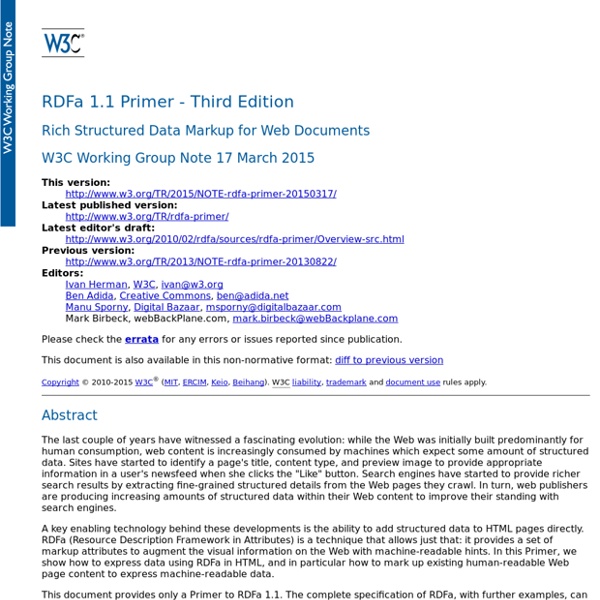Enabling Rich Snippets in Custom Search
Posted by: Rajat Mukherjee, Group Product Manager and Nicholas Weininger, Software Engineer Today, we announced Rich Snippets for Google web search, a new presentation of snippets that highlight structured data embedded in webpages. Rich Snippets provide summary information, including important page-specific attributes, to help you quickly identify the relevance of your results. Experiments on Google have shown that people find this additional data valuable -- if they see useful and relevant information from a webpage, they are more likely to click through to it. Since Custom Search sits on top of the Google web search platform, we're enabling Rich Snippets for custom search engines too. So, if you're using Custom Search or Site Search on your website, you can now control further how your content appears in search results. A sample PageMap for the above example defines custom attributes that are encoded in DataObject tags via the following markup: <!
The Open Graph Protocol
Snipplr - Code 2.0
microdata
microdata is part of WHATWG's HTML living specification that provides another way to embed microformats and poshformats vocabularies, and has been superseded by microformats2. microdata was explicitly dropped by the W3C (and therefore not part of W3C HTML5) due to a lack of interest by anyone to edit the spec and keep it up to date.[1] summary microdata consists of a set of attribute extensions to HTML: itemprop attribute is a more specific version of class, for field names subject attribute allows semantically linking within the page. For common semantics on the web (e.g. people+organizations, events, reviews, syndicated content), microformats are still simpler and easier than microdata, and are already well implemented across numerous tools and services. For uncommon, rare, experimental, or one-off semantics: microdata offers a simpler and easier to understand solution than alternatives that use namespaces like XML/RDF/RDFa. history microdata didn't happen overnight. parsers and tools Note:
Introducing a new Rich Snippets format: Events
Webmaster Level: All Last year we introduced Rich Snippets, a new feature that makes it possible to surface structured data from your pages on Google's search results. So far, user reaction to Rich Snippets has been enthusiastic -- after all, Rich Snippets help people make more informed clicks and find what they need even faster. We originally introduced Rich Snippets with two formats: reviews and people. Events markup is based off of the hCalendar microformat. The new format shows links to specific events on the page along with dates and locations. If you have event listings on your site, we encourage you to review the events documentation we've prepared to help you get started. Stay tuned for more developments in Rich Snippets throughout the year! Written by Mike Danylchuk and Nitin Shetti
RDFa 1.1 with a rich snippet example - W3C Blog
With RDFa 1.1 making its way out of last call, I looked at the examples from Google’s Webmaster Central to see what RDFa 1.1 brings to those. A typical example is the one on reviews; here s where it starts out in RDF 1.0: <div xmlns:v=" typeof="v:Review"><span property="v:itemreviewed">L’Amourita Pizza</span> Reviewed by <span property="v:reviewer">Ulysses Grant</span> on <span property="v:dtreviewed" content="2009-01-06">Jan 6</span>. <span property="v:summary">Delicious, tasty pizza on Eastlake!</span><span property="v:description">L'Amourita serves up traditional wood-fired Neapolitan-style pizza, brought to your table promptly and without fuss. An ideal neighborhood pizza joint. The most important change is that RDFa 1.1 has moved away from using XML namespaces as a syntax for identifying vocabularies. The change looks small, but it means that the author has less complexity to worry about. Actually… the vcard case, specifically, may be even easier.
Better recipes on the web: Introducing recipe rich snippets
Webmaster Level: All Anticipating the start of the season of barbecues and potlucks, we’ve added recipes as our newest rich snippets format. This means that for certain sites with recipe content, Google users will see quick facts when these recipe pages show up as part of the search results. For example, if you were searching for an easy to make thai mango salad, you can now see user ratings, preparation time, and a picture of the dish directly in search result snippets. Recipes is the fifth format we support, following the introduction of reviews, people, video and, most recently, events. If you have recipe content on your site, you can get started now by marking up your recipes with microdata, RDFa, or the hRecipe microformat. Please remember that to ensure a great user experience we’re taking a gradual approach to surface rich snippets. Written by Jun Gong, Kosuke Suzuki, and Yu Watanabe



